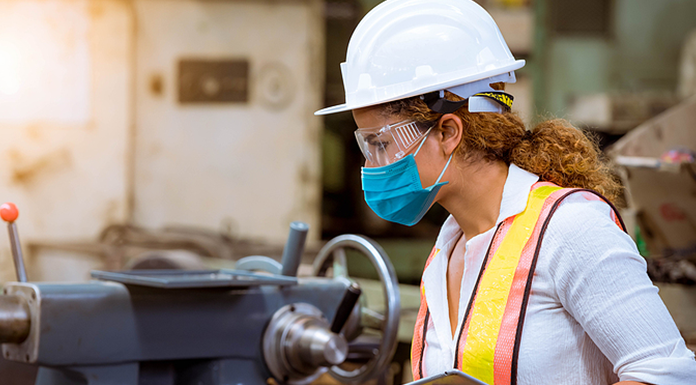Years ago, the women trailblazers working in construction became aware that their Personal Protection Equipment (PPE) did not fit as it should have. Gloves, hard hats, vests, uniforms, masks, and even simple dust/particle masks caused more problems than providing protection.
In 1982, my safety career started after having a mishap wearing (issued) man-sized rawhide gloves while using a rented electric chain saw. The fingertips of the gloves were two inches longer than my actual fingers. When attempting to clear the chain of caught leaves, the right thumb tip of the glove was pulled into the chain with my thumb in the glove. A few stitches later, I was placed on modified duty as a safety coordinator.
Historically, women have had limited options for Personal Protective Equipment, more commonly referred to as PPE. It was not profitable for many companies to produce gender-specific PPE when only 6% of the construction industry from 1965 to 1978 were women.
Today, with a growing number of women in these jobs, the requirements for flame-resistant clothing such as gloves, masks, and other safety garments have risen to over 13%. Several safety vendors are offering PPE that has women in mind. Some of these needs came to light for other industries during the Covid-19 pandemic and the N-95 mask mandates. I witnessed many women wearing the “one size fits all” masks that almost covered their eyes. The staff at a business I was working with had no idea that respirators and masks are available in different sizes based on facial height.
A common PPE question I hear from my male counterparts is “do they design personal fall protection harnesses for women since we have different anatomies?” The answer is similar for most PPE questions, “everyone’s body is different.” That goes for men too. PPE recommendations will not be perfect for everyone, and no, one size does not fit all!
Nowadays, there are excellent choices for women who need to wear a harness regularly and want to have quality equipment. For example, the harness designed for women has leg and shoulder straps that distribute the weight evenly across the body while the straps in front gather together and are connected with a central carabiner. This can provide greater comfort for some women users.
Test PPE before using
PPE used by women workers should be based upon female anthropometric (body measurement) data. Women should make a point to test employer-provided PPE. If the provided PPE is uncomfortable or not suitable for the worker (e.g., improperly fitting or damaged from wear or defect), they should report this condition to their employer for a suitable replacement.
PPE must fit properly to effectively protect the employee from the hazard for which it was designed. Today there has been tremendous progress in the availability of PPE for women. The International Safety Equipment Association (ISEA) reports that many employers now provide a full range of sizes for PPE.
Why proper fitting PPE is so important
- Proper coverage – To quote OSHA, “If the Personal Protective Equipment does not fit properly, it can make the difference between being safely covered or dangerously exposed.” For example, PPE designed to protect from arc flash and flash fire should properly cover skin since exposed skin in an arc flash can result in severe burns. This is also true of an ill-fitting mask that will not seal properly to the smaller faces of some women, which can expose us to harmful chemicals.
- Ideal body fit – PPE that contours to the shape of our body will ensure that we can work comfortably without the risk of unnecessary hazards such as not getting the sleeve caught in or snagged on machinery or other items present in the workplace. We need to ensure we have a full range of motion, especially in physically demanding roles like linework.
- Maximizes protective characteristics – A proper fit will ensure the garment we wear gives us the maximum amount of protective potential in the event of a hazard.
- Comfort on the job – A better fit means better comfort! How much time do we spend looking for those perfectly fitting jeans? Do we look at the average fit? Usually. not. We want those jeans not only to fit well but also to be comfortable. Same with the PPE we wear all day on the job. Better comfort helps to encourage better work, and feeling comfortable in work clothes is essential to reducing the stress of a physical job. Would you believe a comfortable worker is a happier worker?
Why men’s garments don’t work for women
Let’s look at why traditional men’s tailoring wouldn’t work for a woman’s shirt:
- Women tend to have more narrow shoulders/neck — this results in “swimming” in a shirt or too much excess room throughout the upper torso
- The sleeves will extend past the wrists
- Narrow waist/hip construction does not follow a woman’s curves — a men’s design will feel tight at the hips but too large in the shoulders, almost the exact opposite of how it would fit for men
- The shirt may be too long for many women causing more of a hazard than a fashion statement
Best Practice: In addition to compliance with the OSHA regulations, whenever employers are required to purchase PPE, they should purchase these items in size ranges suitable for women if they have women in their workforce. Employers should maintain a directory of PPE manufacturers and suppliers on hand, identify a wide selection of size ranges for PPE, keep appropriate size ranges in stock, and ensure direct accessibility, as required. Remember: One size does not fit all!

















